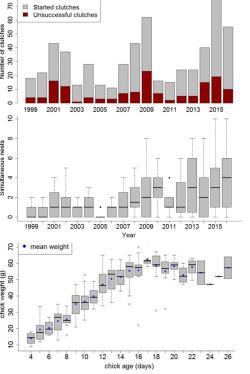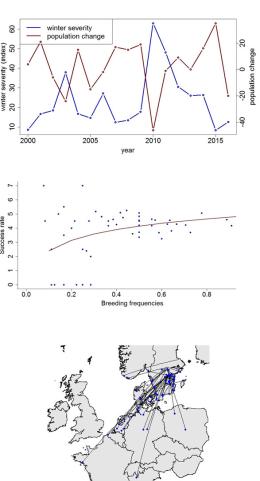Results

During the 18 year long sample period, a total of 567 clutches were recorded. There was a large variation in number clutches between years (Figure 1). Out of the 567 clutches, 148 were unsuccessful (26%). Failure rates varied between 43.8% in 2010 and 7.7% in 2003, with an average of 24.6%. In 13 cases, the chicks were entirely missed. The remaining 406 clutches produced 2445 chicks in total. The highest number of chicks were ringed in 2015 (330 chicks) and the lowest in 2005 (35 chicks). Average breeding success per nest was 4.58 chicks, with 2010 being the lowest year (3.3 chicks/nest) and 1999 the highest (6.0 chicks/nest). Only 2 nests with more than 7 eggs (8 eggs) were recorded, resulting in 5 and 7 chicks.
Mean number of simultaneous breedings within 5 km was highest in 2013 and lowest in 2005 (0.4) (Figure 1), depending strongly on the site. The highest amount of simultaneous breedings were 10 in K14B (2015), K17B (2016) and K74 (2015).
Age of the chicks ranged between 6 and 26 days when ringed, with the highest proportion ringed between 5 and 18 days. Chick’s weights varied according to their age (Figure 1). In the beginning, weight increased almost linear, with a gain of about 2.5 g per day up to an age of about 17 days. The chick weights peaked around 60-70 g. With increasing age they lost weight again and reached 50-60 g when fledging. From 567 breeding pairs, 181 male and 232 female breeding birds could be caught, 29 of them with a net. Of them, 220 were unringed, 197 controlled. In 90 breeding occasions, both, male and female were captured. They showed an average weight of 43.6, with females 45.3 g and males 42.0 g.

Winter influence:
The number of started clutches and hence the number of chicks was influenced by the winter severity of the respectively previous year. Strong winters thereby led to fewer nests in the following year (F(1,15)= 7.20, p<0.01), as well as to later starts of breedings (F(1,16)= 5.92, p<0.05) (Figure 2). The overall percentage of unsuccessful clutches, however, was not influenced by winter severity.
Breeding success:
Respectively, the weight of the chicks, as well as the weight of the breeding parent in the first clutch remained constant over the years. Success rates of clutches varied heavily between sites, while winter severity of the previous year and overall number of breedings did not seem to have an influence on the rates. Parents’ weights dropped during the year (F(1,88)= 21.12, p<0.001), however, did not depend on the site they were breeding at. Females thereby were slightly heavier than males (F(2,218)= 30.17, p<0.001).
With an increasing amount of neighbors breeding at the same time within five kilometers, success rates for each clutch decreased when controlled for breeding frequency (F(3,48)= 10,73, p<0.001) (Figure 2). However, neither abortion rate nor chicks weight was affected by the amount of simultaneous breedings. With increasing breeding frequency, nests showed a logarithmic increase in breeding success, even though the most frequented sites were not the sites with highest breeding success per clutch. Less frequented sites showed higher density fluctuation according to the population size, while higher frequented areas were more constant and only showed minor influences.
Habitat structure:
From all nesting sites, only 35 sites around Linköping were assessed for habitat structure. Wall size and orientation, water distance and soil clay content showed no dependency on each other in the PCA. Also the quasibinomial model indicated no strong effects of either of the parameters on the breeding frequency.
Migration:
From 2665 kingfisher chicks and adults ringed in the summer months April to September, 394 were recovered, 32 of them in the months October to March. The longest distance to the ringing location was thereby 1637 km (Figure 2).
Responsible for this page:
Director of undergraduate studies Biology
Last updated:
05/11/17
